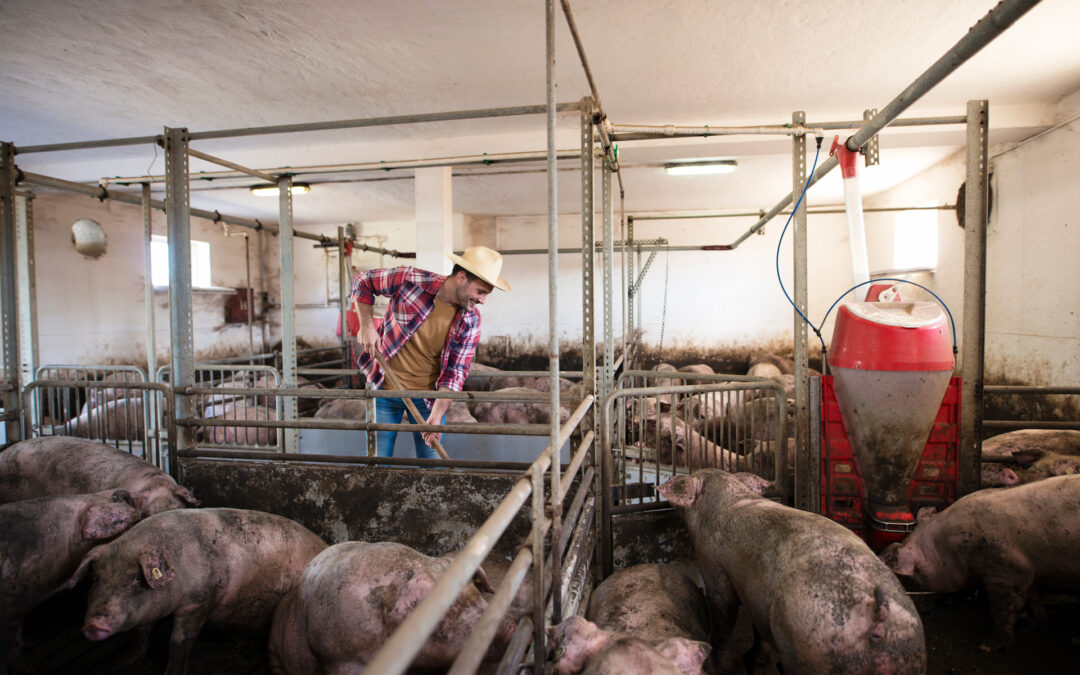The swine industry has made great strides over the last decades in the transition from pasture systems to confinement and large facilities, which has led to more specialized, standardized, and efficient operations. However, new scenarios can also bring new issues, foaming being one of them. In many farms, pig manure is stored beneath a slatted floor housing in 2.4–3-meter-deep pits for extended periods, usually between 6 and 12 months (Yang et al., 2021). Foam accumulation in deep-pit finishing barns has been associated with explosions and flash fires due to the buildup of flammable gasses, which poses a critical logistical and safety issue for swine producers. Regarding this very important topic, this article addresses the key questions that arise regarding foaming issues:
- How does deep pit foaming happen?
- When and where is foaming more likely to occur?
- What are the consequences of foaming in swine barns?
How does deep pit foaming happen?
Once considered a “mystery” in the past, the reasons that foaming occurs have become clearer. Foaming happens when multiple factors interact to produce and trap a large amount of biogas (especially methane), emitted during the anaerobic decomposition of stored manure (Van Weelden et al., 2015). During the process of disrupting the manure, bursts of biogas are released, containing 50-70% of methane by volume. Combined with ambient air, high biogas concentration can reach explosive levels. As a result, an explosion or flash fire can occur in the barns when a heater or motor is operated, or a light switch is turned on (Clanton et al., 2012).
Thus, foaming depends on a combination of three main factors. First, biogas must be produced by biological activity in the manure. Then, active agents (microorganisms in the slurry) must encapsulate the gas bubbles and trap them at the surface. Finally, hydrophobic solids are also essential, as they stabilize the foam. Without any of those elements, foaming does not occur.
When and where is foaming more likely to occur?
Foaming on manure surfaces in a deep-pit barn is not a new challenge and occurs more often than you might think. Many swine producers across the US have been watching its deleterious effects during the last few years, especially those who raise their animals in the upper Midwest. Most incidences of barn explosions due to foaming are reported in Minnesota, Iowa and Illinois. Also, foaming incidents have been continuously increasing, especially after 2008, when spontaneous foaming was considered rare (Clanton et al., 2012). Along with regionality, seasonality should also be another factor to be considered – foaming cases often happen during the summer and fall months.
To better understand how foaming incidents impact the Midwest’s pig farms, Akdeniz et al. (2013) conducted a survey with 225 producers from Iowa, Illinois, Missouri, Michigan, and Indiana. A total of 1,388 spaces (65.5% grow-finish and 34.5% wean-to-finish) and 1334 deep-pits were evaluated in this study. Surprisingly, results showed that 322 pits (24.1% out of the total) presented foam, while 132 producers (58.7%) reported they had at least one foaming pit, and 13 producers (9.8%) witnessed an explosion or a flash fire.
What are the consequences of foaming in swine barns?
One of the many reasons foaming should be considered a hot topic in our industry is its catastrophic results (Strom et al., 2022). First, explosions can lead to the destruction of a building. Consequently, not only is the building’s structure damaged, but a great amount of equipment is also lost. Then, we should also consider the pigs: many of them can be severely burned, which can cause losses due to death and culling. It has already been reported, for example, that up to 1,500 pigs were killed in a single explosion in Iowa due to foaming. Moreover, although no human death has been documented so far, workers can also be injured when exposed to life-threatening fires or intense heat. It also merits noting that foaming also reduces manure storage capacity (Yan et al., 2014), often coming through floor slats and posing a risk to both pigs and workers. Based on all the harmful consequences described above, foaming is not only a safety issue but can have significant financial impacts as well.
Acknowledgment is key
There is a lot we still have to learn about foaming. However, it should no longer be considered a mysterious issue and, moreover, should not be underestimated – even by swine producers outside the Midwest. Solving this issue on your pig farm starts with quality information. Check out our upcoming articles for more information on foaming, including the causes, effects, and efficient ways to control it.
References
Akdeniz, N., Jacobson, L. D., Clanton, C. J., & Hetchler, B. P. (2013). Survey on foaming deep-pit swine manure. In 2013 Kansas City, Missouri, July 21-July 24, 2013 (p. 1). American Society of Agricultural and Biological Engineers.
Clanton, C., Jacobson, L., & Schmidt, D. (2012). Monensin addition to swine manure deep pits for foaming control. University of Minnesota Extension Fact Sheet.
Strom, N., Ma, Y., Bi, Z., Andersen, D., Trabue, S., Chen, C., & Hu, B. (2022). Eubacterium coprostanoligenes and Methanoculleus identified as potential producers of metabolites that contribute to swine manure foaming. Journal of Applied Microbiology, 132(4), 2906-2924.
Van Weelden, M. B., Andersen, D. S., Trabue, S. L., Kerr, B. J., Rosentrater, K. A., & Pepple, L. M. (2015). An evaluation of the physicochemical and biological characteristics of foaming swine manure. Transactions of the ASABE, 58(5), 1299-1307.
Yan, M., Kandlikar, G., Jacobson, L., Clanton, C., & Hu, B. (2014). Laboratory storage simulation to study swine manure foaming. Transactions of the ASABE, 57(3), 907-914.
Yang, F., Andersen, D. S., Trabue, S., Kent, A. D., Pepple, L. M., Gates, R. S., & Howe, A. S. (2021). Microbial assemblages and methanogenesis pathways impact methane production and foaming in manure deep-pit storages. PloS one, 16(8), e0254730.
